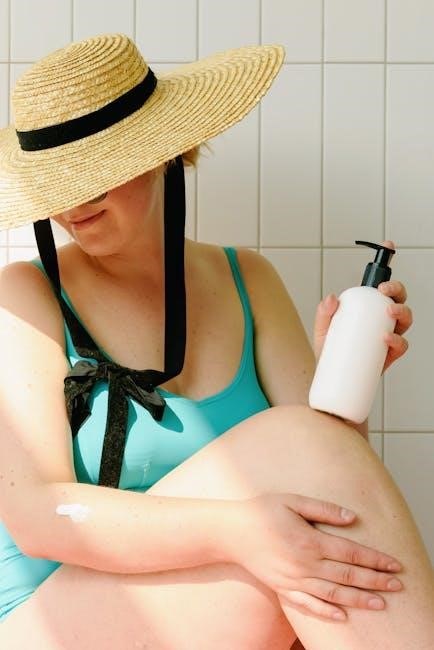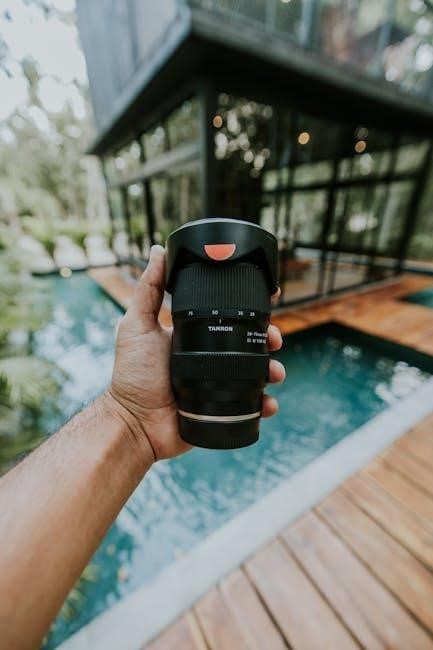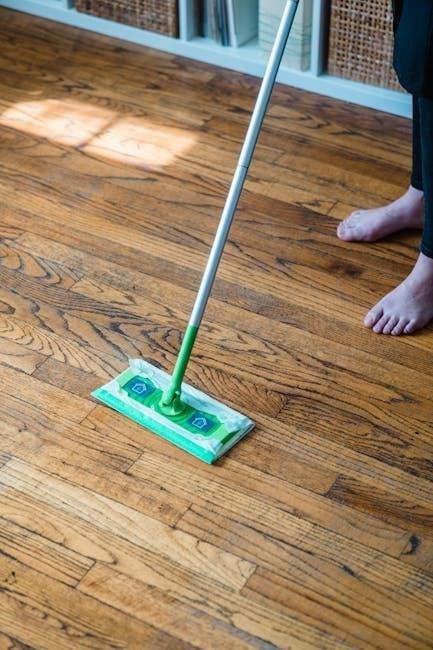How to Use a Manual Pool Vacuum: A Comprehensive Guide
Learn how to effectively clean your pool with a manual vacuum. This guide covers essential steps, tools, and tips for efficient and thorough pool maintenance, ensuring sparkling water.
A manual pool vacuum is a essential tool for maintaining a clean and hygienic swimming pool. Unlike automated cleaners, manual vacuums require physical effort but offer precise control over the cleaning process. They typically consist of a vacuum head, a long hose, and a pole, allowing users to target debris on the pool floor and walls effectively. Manual vacuums are cost-effective and ideal for small to medium-sized pools. They are also a great backup option for pools equipped with automatic cleaners. With proper technique, manual vacuums can remove dirt, leaves, and sediment, ensuring crystal-clear water. They are especially useful for spot cleaning or when a thorough manual scrub is needed. Regular use helps maintain pool health and extends the lifespan of your pool equipment.

Benefits of Using a Manual Pool Vacuum
Manual pool vacuums offer several advantages for pool owners. They are cost-effective and provide precise control over cleaning, allowing you to target specific areas. Unlike automated cleaners, manual vacuums require no electricity, making them eco-friendly and energy-efficient. They are also lightweight and easy to store, perfect for small to medium-sized pools. Manual vacuums are ideal for spot cleaning and can be used as a backup when automatic cleaners are not available. They are also a great option for pools with unique shapes or tight spaces that automated cleaners struggle to reach. Regular use of a manual vacuum helps maintain clean water, reduces the strain on your pool filter, and prolongs the lifespan of your pool equipment. Overall, they are a practical and reliable tool for keeping your pool clean and well-maintained.

Preparing for Manual Pool Vacuuming
Gather essential tools, assemble the vacuum, and ensure the pool filter and pump are ready for optimal performance before starting the cleaning process.
Gathering Essential Tools and Equipment
To begin, collect all necessary tools for manual pool vacuuming. These include a sturdy vacuum head, a flexible hose, a telescoping pole, and a debris bag or attachment. Ensure the vacuum head is weighted for stability, especially for vinyl-lined pools, to prevent damage. The telescoping pole should be adjustable to reach all areas of the pool. Additionally, check that the hose is long enough and free of kinks to maintain consistent suction. For effective cleaning, some vacuums come with side brushes to tackle tough spots. Having a universal adapter ensures compatibility with various pool systems. Finally, wear gloves for grip and protection while handling the equipment. Proper preparation ensures a smooth and efficient cleaning process, making your pool maintenance routine easier and more effective. By gathering all these tools beforehand, you can avoid interruptions and focus on achieving a sparkling clean pool.
Assembling the Manual Pool Vacuum
Assembling your manual pool vacuum is straightforward but requires attention to detail. Start by attaching the vacuum head to the telescoping pole, ensuring a secure connection. Next, connect the hose to the vacuum head, making sure it is tightly fitted to avoid air leaks. If your vacuum includes a debris bag or adapter, attach it according to the manufacturer’s instructions. Check all connections for compatibility with your pool’s system, especially if using a universal adapter. Once assembled, submerge the vacuum head in water to expel air and ensure proper suction. Test the setup by moving it gently across the pool floor to confirm it functions correctly. Proper assembly ensures efficient cleaning and prevents issues during use. Take your time to double-check each part for a seamless experience. This step is crucial for achieving optimal results.
Checking the Pool Filter and Pump
Before using your manual pool vacuum, it’s crucial to ensure your pool’s filter and pump are in good working condition. Start by checking the type of filter you have—whether it’s a sand, DE, or cartridge filter—and understand its specific maintenance requirements. For sand filters, monitor the pressure gauge; backwash when the pressure exceeds the recommended level. For DE filters, ensure the grid is clean and recharge with DE powder as needed. Inspect the pump to ensure it’s running smoothly and providing adequate suction power. Check for any blockages in the intake or impeller. Ensure all connections and hoses are secure and free of leaks to maintain optimal suction. Address any issues with the filter or pump before vacuuming to ensure effective cleaning. Proper maintenance of these components is essential for efficient manual pool vacuuming and to prevent potential damage to your equipment.
Using the Manual Pool Vacuum
Master the process of manually vacuuming your pool for a clean and sparkling finish. This section provides step-by-step guidance on submerging the vacuum head, adjusting suction power, and efficiently cleaning pool surfaces.
Submerging the Vacuum Head
Submerging the vacuum head is a crucial step in manual pool vacuuming. Start by connecting the vacuum hose to the skimmer or dedicated suction line. Ensure the vacuum head is fully submerged by slowly lowering it into the water. For pools with vinyl liners, weighted vacuum heads are ideal as they stay in contact with the pool floor. Once submerged, check for any air leaks in the hose connections to maintain proper suction. For easier submersion, some vacuum heads can be deflated before being placed underwater. Properly submerging the head ensures effective cleaning and prevents debris from escaping back into the pool. This step is essential for achieving a thorough and efficient cleaning process.
Adjusting Suction Power
Adjusting suction power is essential for effective pool vacuuming. Start by setting the suction power to a low or medium level to avoid stirring up debris. Use the regulator or valve on the suction line to control the flow. If the vacuum is too powerful, it may scratch the pool floor or walls, especially in vinyl-lined pools. Conversely, insufficient suction may fail to pick up debris. Adjust the power based on the type of debris and pool surface. For finer particles or algae, increase suction gradually. Always monitor the filter pressure gauge; if it exceeds recommended levels, reduce suction to prevent damage to the pump or filter system. Proper adjustment ensures efficient cleaning without risking damage to your pool or equipment.
Vacuuming the Pool Floor and Walls
Begin by vacuuming the pool floor in slow, overlapping passes, starting from the shallow end. Use the weighted triangular head to glide smoothly across the surface. For walls, angle the vacuum head to reach corners and crevices. Use the side brush attachment for detailed cleaning. Avoid applying too much pressure, which can stir up debris. For stubborn spots, hover over the area briefly to loosen particles before vacuuming. After completing the floor and walls, check the pump basket and filter for debris. Regular vacuuming prevents algae buildup and maintains clear water. Ensure all areas are covered, including steps and benches, for a thorough clean.

Maintenance and Safety Tips
Regularly inspect hoses and connections for damage. Store the vacuum in a dry, shaded area to prevent damage. Always supervise children during use and avoid sharp objects near the pool.
Cleaning and Storing the Vacuum
After each use, rinse the vacuum head and hose with fresh water to remove debris. Regularly inspect for damage and replace worn parts. Store in a dry, shaded area to prevent sun damage and extend lifespan. Clean or replace filters as needed to maintain suction power. Always ensure the vacuum is completely dry before storage to prevent mold growth. Proper maintenance ensures optimal performance and longevity of your manual pool vacuum.
Regular Maintenance for Optimal Performance
Regular maintenance is crucial for ensuring your manual pool vacuum operates efficiently. After each use, clean the vacuum head, hose, and any attachments to remove dirt and debris. Check for signs of wear or damage and replace parts as needed. Lubricate moving components periodically to maintain smooth operation. During off-seasons, store the vacuum in a dry, protected area to prevent rust or mold. Regularly inspect and clean the pool filter to ensure proper suction power. By following these maintenance steps, you can extend the lifespan of your manual pool vacuum and keep your pool clean with minimal effort.

Troubleshooting Common Issues
Identify and resolve issues like low suction or clogs. Check filter pressure, ensure proper hose connections, and clear blockages. Regular maintenance can prevent many common problems.
Low Suction Power
Low suction power can hinder effective pool cleaning. Check for blockages in the hose, vacuum head, or skimmer. Ensure the pool filter is clean, as dirty filters reduce suction. Backwash or clean the filter if pressure exceeds 30 psi. Verify all connections are secure and inspect for air leaks, which can weaken suction. Use the correct nozzle size for your vacuum head to maintain optimal flow. If issues persist, consider upgrading to a more powerful pump or adjusting the vacuum settings. Regular maintenance, like cleaning the filter and inspecting hoses, can help prevent suction problems. Addressing these issues ensures efficient cleaning and keeps your pool sparkling.

Clogging and Blockages
Clogging and blockages are common issues that can disrupt manual pool vacuuming. These often occur when debris like leaves or dirt accumulates in the vacuum head, hose, or connections. To resolve this, turn off the pump and inspect the vacuum head and hose for obstructions. Use a garden hose to flush out any debris from the hose and connections. Ensure the skimmer basket and pool filter are clean, as clogged filters can reduce water flow. Regularly cleaning the vacuum head and checking for worn-out parts can prevent blockages. Additionally, using a filter screen can help trap larger debris before it enters the vacuum system. Addressing these issues promptly ensures smooth operation and efficient pool cleaning.

Regular maintenance and correct techniques ensure your pool stays clean. Troubleshooting issues promptly prevents equipment damage. With these tips, you’ll master manual pool vacuuming efficiently.
Final Tips for Effective Manual Pool Vacuuming
For optimal results, always use the correct suction setting for your pool type. Regularly inspect and clean the vacuum head to prevent clogs. Store the equipment properly to extend its lifespan. Check the pool filter pressure before vacuuming, as high pressure can reduce suction efficiency. Avoid vacuuming large debris, as it may damage the equipment or clog the system. Use a slow, steady motion to cover the entire pool floor and walls thoroughly. After vacuuming, rinse the hose and head with clean water. Inspect the pool for any missed spots and repeat if necessary. Regular maintenance ensures your manual pool vacuum performs effectively, keeping your pool clean and safe for swimming.
